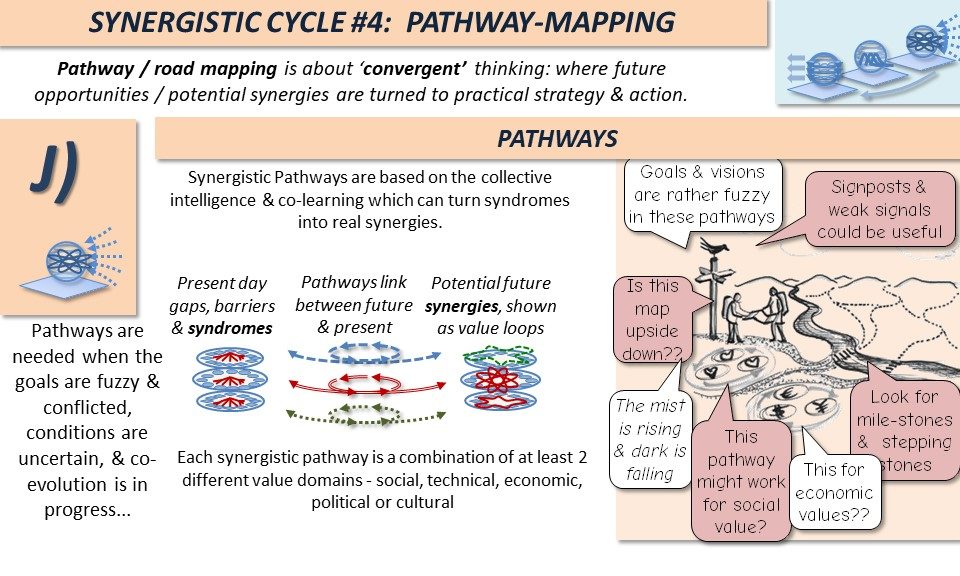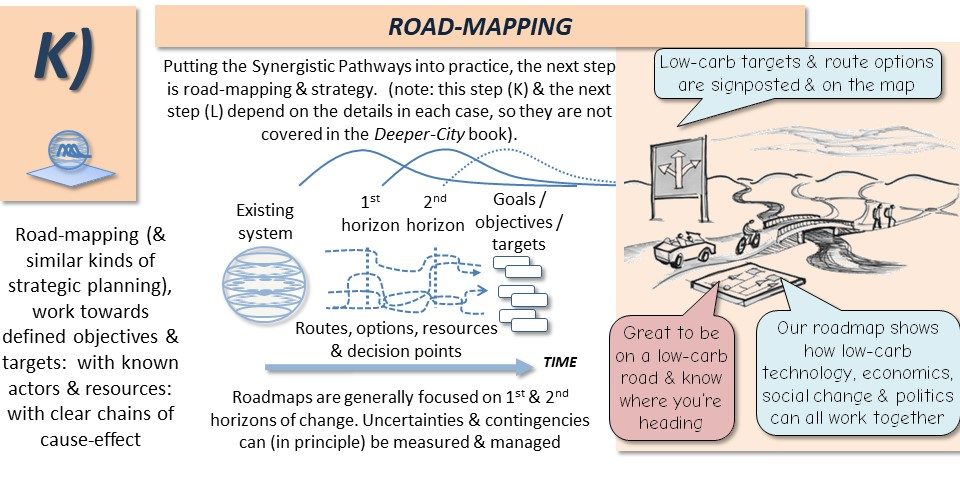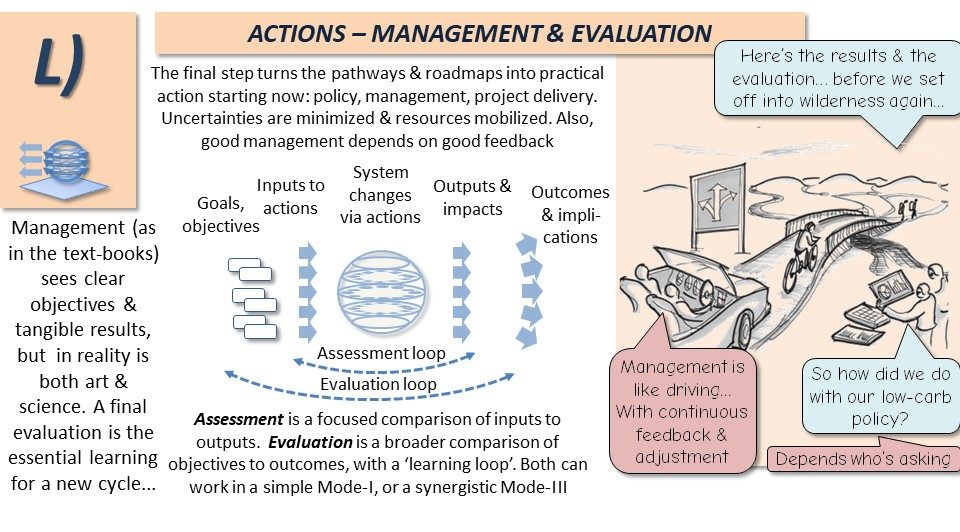Toolkit 4 – Strategies
The fourth stage is ‘convergent thinking’, where future potentials are linked to present actions.
Step (J): Pathway-mapping
A Synergistic Pathway is a kind of mental journey, which turns the potential synergies, from the previous 3 steps, towards realities. Such pathways often cross an uncertain landscape, with fuzzy destinations, conflict among travellers, and a lack of maps to follow. There are different levels:
- Mode-I pathways are often focused on functional or technical modelling: the Low-Carb City would use energy analysis, extended to economic or policy issues.
- Mode-II ‘smart’ transition pathways are more about evolution, innovation, incentives and competition: the Low-Carb City could use evolutionary economics.
- Mode-III ‘synergistic’ pathways explore the potential for social learning, co-creation, co-production, and the overall collective intelligence: the Low-Carb City would explore the potential for co-learning and co-creation for urban transformation.
Synergistic pathways, can be focused on actors, or factors. They can be focused on combinations of domains: a Low-Carb city driven by social valuation / ecological ethics. The Deeper-City book shows many different types as examples of what can be useful. Synergistic pathways adapt to uncertainties or risks across the STEEP range (social, technical, economic, political): they also respond to negative forces, such as corruption, alienation, hierarchy and others. For guidance we look for stepping stones, milestones, or signposts. Overall, a synergistic pathway is about the practicals of transformation, from ‘syndromes’ to ‘synergies’, and so is adaptable, improvised, collaborative, self-organizing and self-questioning.
For Low-Carb city: a social innovation pathway would look for community re-investment in greenspace & neighbourhood facilities. A financial pathway looks for financial innovation, social crowd-funding & inter-generational collateral. And so on.

Step (K): Road-mapping
Road-mapping follows, along with similar forms of strategic planning. A road-map generally works with more clear objectives and targets, more definition of actors and resources, and more specific ways to mobilize them. While ‘pathways’ generally point towards a 3rd horizon of change, road-maps are more focused on the 1stand 2nd horizon. There may be uncertainties and contingencies to be resolved, but at least (in the jargon) these are ‘known unknowns’.
The wider uncertainties don’t come into road-maps too much, neither the darker factors of corruption or alienation. This highlights the contribution of synergistic thinking. The Mode-II and Mode-II forms of road-mapping are about tangible targets and actions, but they could fall down at the first unforeseen human factor or wild card. In contrast, a synergistic Mode-III type road-mapping focuses on these human factors of co-learning, co-creation and collective intelligence. It includes for corruption and alienation and the processes, better suited to bridging the aspiration-reality gap.
For the Low-Carb housing agenda: we need a detailed road-mapping with energy / emissions modelling: demographic or economic projections: and retrofit / construction schedules. A synergistic mode-III roadmap then shifts towards reality checks, e.g. fragmentation of housing stock, alienation of residents, or inertia of construction, and looks for responses.

Step (L): Management & Evaluation
Finally we get to the stage of policies, projects, decision-making and management. These are covered by countless business and management text-books, mainly with a linear mode-I ‘logical framework’ in mind. This generally assumes that we ‘pull a lever’, that objectives are clear, inputs and outputs are known, and outcomes can be measured. Policy and management is then about ‘cybernetic’ monitoring and adjustment: and the assessment and evaluation loops also assume a machine which is well-oiled. The Mode-II evolutionary approach is more focused on competition, innovation, entrepreneurs and incentives: smart psychology or behavioural economics are useful here, e.g. as in ‘nudge theory’.
In contrast a Mode-III co-evolutionary policy and management is more about co-learning and co-production, between policy-makers / managers, workers / suppliers, and stakeholders / users. A Mode-III business model and management style is more about relationships and communities, upstream and downstream. Likewise, Mode-III assessment and evaluation are not just about functional cause-effect – more about synergistic opportunities and transformation effects.
For the Low-Carb housing: to upgrade 1 million dwellings, we need Mode-I type construction schedules and skills profiles. We also need Mode-II type finance packages, procurement platforms and innovation competitions. We also need Mode-III actions, such as community energy companies, neighbourhood mentors, climate learning schemes and social co-production in public health or social enterprise.

